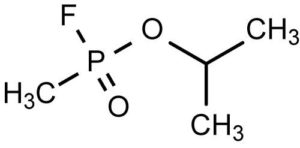
Whiskey on the rocks.
Add a spalsh of water to your whiskey. If you’ve ever done a whiskey tasting or been to a whiskey bar you’ve probably received this advice. “It’ll bring out the full flavor, especially if it’s a Scotch”. Now there is Science to back that advice up.

Guaiacol. One of the molecules that give whiskey its characteristic smokiness.
Whiskies have a compound called guaiacol, which gives it its characteristic smokiness. Scotch whiskies typically have more guaiacol than their American or Irish counterparts because it is made with malted barley that has been smoked over a peat fire. Guaiacol is a phenol, and when it is in a solution of ethanol and water, as in whiskey, it tends to interact more with ethanol molecules than water. When whiskey is more concentrated, ethanol and guaiacol form clumps and sink deeper into the glass. But, when its diluted by a splash of water or with an ice cube, the ethanol and guaiacol are more dispersed and accumulate toward the liquid surface. This makes the whiskey smell and taste more flavorful.
So what is the optimal dilution? There is no one answer to this question. The optimal dilution for bringing out a whiskey’s flavor will vary from brand to brand. And giving your whiskey glass a gentle swirl before each sip won’t hurt either.
Read more about the research by Björn Karlsson and Ran Friedman in Scientific Reports.
